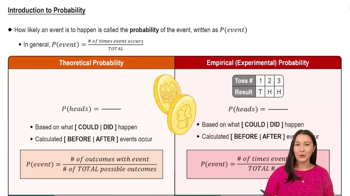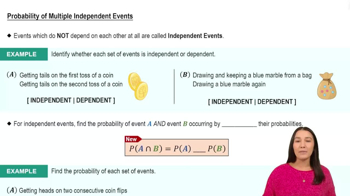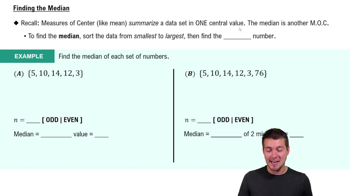1. When two events are mutually exclusive, why is P(A and B) = 0?
Table of contents
- 1. Intro to Stats and Collecting Data1h 14m
- 2. Describing Data with Tables and Graphs1h 55m
- 3. Describing Data Numerically2h 5m
- 4. Probability2h 16m
- 5. Binomial Distribution & Discrete Random Variables3h 6m
- 6. Normal Distribution and Continuous Random Variables2h 11m
- 7. Sampling Distributions & Confidence Intervals: Mean3h 23m
- Sampling Distribution of the Sample Mean and Central Limit Theorem19m
- Distribution of Sample Mean - Excel23m
- Introduction to Confidence Intervals15m
- Confidence Intervals for Population Mean1h 18m
- Determining the Minimum Sample Size Required12m
- Finding Probabilities and T Critical Values - Excel28m
- Confidence Intervals for Population Means - Excel25m
- 8. Sampling Distributions & Confidence Intervals: Proportion1h 12m
- 9. Hypothesis Testing for One Sample3h 29m
- 10. Hypothesis Testing for Two Samples4h 50m
- Two Proportions1h 13m
- Two Proportions Hypothesis Test - Excel28m
- Two Means - Unknown, Unequal Variance1h 3m
- Two Means - Unknown Variances Hypothesis Test - Excel12m
- Two Means - Unknown, Equal Variance15m
- Two Means - Unknown, Equal Variances Hypothesis Test - Excel9m
- Two Means - Known Variance12m
- Two Means - Sigma Known Hypothesis Test - Excel21m
- Two Means - Matched Pairs (Dependent Samples)42m
- Matched Pairs Hypothesis Test - Excel12m
- 11. Correlation1h 6m
- 12. Regression1h 50m
- 13. Chi-Square Tests & Goodness of Fit1h 57m
- 14. ANOVA1h 57m
4. Probability
Addition Rule
Problem 3.3.13
Textbook Question
13. Students A physics class has 40 students. Of these, 12 students are physics majors and 16 students are minoring in math. Of the physics majors, three are minoring in math. Find the probability that a randomly selected student is minoring in math or a physics major.
 Verified step by step guidance
Verified step by step guidance1
Step 1: Identify the relevant sets and their sizes. The total number of students is 40. The number of physics majors is 12, the number of students minoring in math is 16, and the number of students who are both physics majors and minoring in math is 3.
Step 2: Use the formula for the union of two sets to calculate the probability. The formula is: \( P(A \cup B) = P(A) + P(B) - P(A \cap B) \), where \( A \) is the event of being a physics major and \( B \) is the event of minoring in math.
Step 3: Calculate \( P(A) \), the probability of being a physics major. This is given by \( \frac{\text{Number of physics majors}}{\text{Total number of students}} \), which is \( \frac{12}{40} \).
Step 4: Calculate \( P(B) \), the probability of minoring in math. This is given by \( \frac{\text{Number of students minoring in math}}{\text{Total number of students}} \), which is \( \frac{16}{40} \).
Step 5: Calculate \( P(A \cap B) \), the probability of being both a physics major and minoring in math. This is given by \( \frac{\text{Number of students who are both}}{\text{Total number of students}} \), which is \( \frac{3}{40} \). Substitute these values into the union formula to find \( P(A \cup B) \).
 Verified video answer for a similar problem:
Verified video answer for a similar problem:This video solution was recommended by our tutors as helpful for the problem above
Video duration:
2mPlay a video:
Was this helpful?
Key Concepts
Here are the essential concepts you must grasp in order to answer the question correctly.
Probability
Probability is a measure of the likelihood that a particular event will occur, expressed as a number between 0 and 1. In this context, it involves calculating the chance of selecting a student who is either a physics major or minoring in math from a total group of students. Understanding how to compute probabilities is essential for solving the given question.
Recommended video:

Introduction to Probability
Union of Events
The union of two events refers to the occurrence of at least one of the events. In this case, we are interested in the union of the events 'being a physics major' and 'minoring in math.' The formula for the probability of the union of two events is P(A ∪ B) = P(A) + P(B) - P(A ∩ B), which accounts for any overlap between the two groups.
Recommended video:

Probability of Multiple Independent Events
Set Theory
Set theory provides a framework for understanding collections of objects, which in this case are the students categorized by their academic focus. By using set notation, we can define the groups of physics majors and math minors, and analyze their intersections and unions. This helps in visualizing and calculating the probabilities of the combined events effectively.
Recommended video:
Guided course

Calculating the Median

 5:14m
5:14mWatch next
Master Probability of Mutually Exclusive Events with a bite sized video explanation from Patrick
Start learningRelated Videos
Related Practice
Textbook Question
